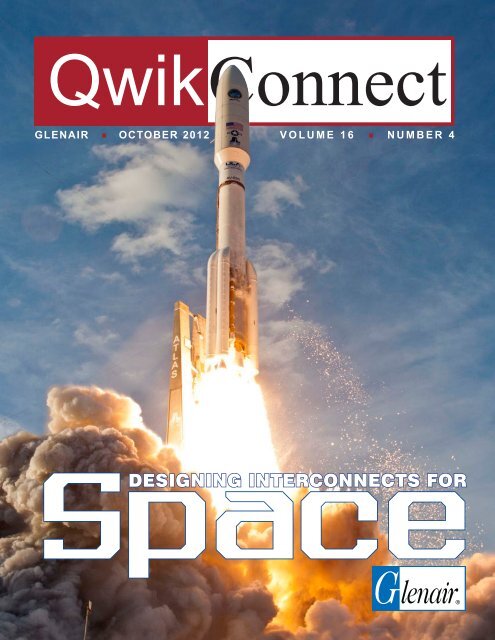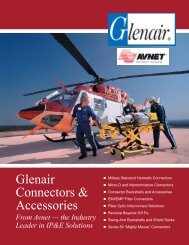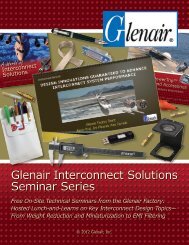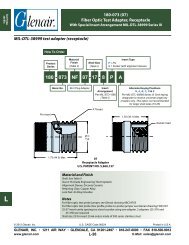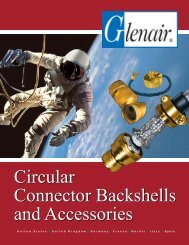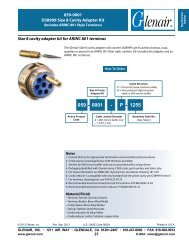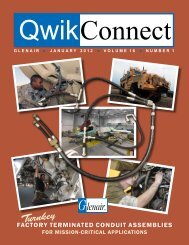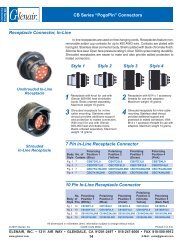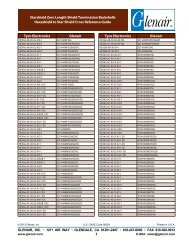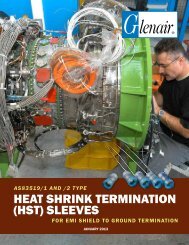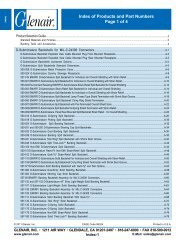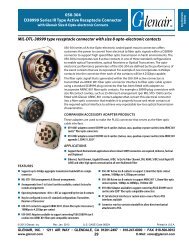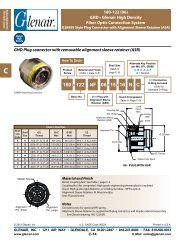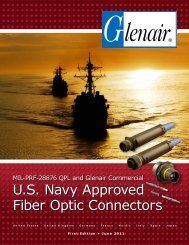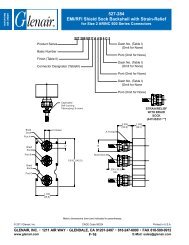Two page spread - Glenair, Inc.
Two page spread - Glenair, Inc.
Two page spread - Glenair, Inc.
Create successful ePaper yourself
Turn your PDF publications into a flip-book with our unique Google optimized e-Paper software.
QwikConnect<br />
GLENAIR OCTOBER 2012<br />
V O L U M E 1 6 N U M B E R 4<br />
• •<br />
Space<br />
DESIGNING INTERCONNECTS FOR
Designing<br />
<strong>Glenair</strong> has been providing Space-Grade<br />
Interconnect Solutions since the earliest manned<br />
space flights. We understand the highly specialized<br />
mechanical, electrical and optical performance<br />
requirements for data, video and communications in<br />
exoatmospheric vehicles. Space-rated interconnect<br />
systems require specialized materials and processing<br />
and precise and reliable mating interfaces. Size and<br />
weight reduction are additional key requirements. All<br />
are <strong>Glenair</strong> strengths.<br />
Space is one of the most severe environments<br />
imaginable. During launch, spacecraft and their<br />
payloads are shaken violently and battered with intense<br />
sound waves. Earth’s atmosphere has an insulating<br />
property, but spacecraft operating beyond this layer<br />
of protection are subjected to shock, vibration, and<br />
acoustic stress factors which can damage interconnect<br />
systems—particularly if material strength, mating<br />
retention forces, contact retention technologies or<br />
other design elements of connector/cable components<br />
are inadequate for peak and/or sustained levels of<br />
mechanical stress.<br />
Temperatures in space can range from extremely<br />
cold—hundreds of degrees below freezing—to many<br />
hundreds of degrees above, especially if a spacecraft<br />
ventures close to the sun. Temperature extremes can<br />
generate stress in metal, glass and polymer materials<br />
and potentially lead to cracking or other failures.<br />
Meteor showers can damage spacecraft and<br />
equipment. Even small dust particles—that appear<br />
from Earth as ‘shooting stars‘—can damage exposed<br />
equipment travelling through space at extremely high<br />
speeds. Damage can range from a sort of ‘sand blasting’<br />
effect on solar panels to even more severe forms of<br />
harm we would normally associate with a gun shot or<br />
bomb blast.<br />
QwikConnect<br />
Interconnects for Space<br />
Corrosion is a serious factor, even in space craft<br />
designed to operate in environments where resistance<br />
to environmental (dust, water and fluid ingress) or<br />
electrolytic hazards is not a requirement. In the first<br />
case, interconnect systems may be subjected to<br />
environmental damage during construction and storage<br />
on earth. Launch vehicles, rockets and ground test<br />
equipment are often challenged by environmental<br />
conditions. In low earth orbit, satellites and stations may<br />
be damaged by atomic oxygen, if material choices and<br />
other amelioration efforts are not carefully made.<br />
Finally, space places a wide range of demands on<br />
design and packaging of interconnect components.<br />
These unique packaging challenges include the<br />
elimination of sharp surfaces that might damage a space<br />
suit, unique coupling technologies for<br />
automated de-mating of staged<br />
modules, ultra-low profile or<br />
reduced weight connectors for<br />
weight and space reduction<br />
and so on.<br />
The general requirements<br />
of designing interconnect<br />
systems for space can be<br />
summarized as follows:<br />
• The overriding<br />
concern for spacegrade<br />
interconnects<br />
is reliability. When<br />
millions of dollars<br />
worth of equipment is at stake—not to mention<br />
invaluable human cargo when brave and talented<br />
women and men take flight—interconnect<br />
components have to work with assured reliability<br />
and safety every time.<br />
• Minimizing weight<br />
and package size<br />
of components,<br />
while maintaining<br />
strength and<br />
durability for spacegrade<br />
operation.<br />
• Systematic<br />
processing and<br />
screening of nonmetallic<br />
materials<br />
to prevent the<br />
outgassing of<br />
condensable<br />
material.<br />
• Utilization of materials and platings that withstand<br />
atomic oxygen corrosion in the space environment.<br />
• Building systems able to withstand the extreme hot<br />
and cold temperatures experienced in space.<br />
• Avoiding use of materials with undesirable<br />
ferromagnetic properties that could interfere with<br />
sensitive instruments on spacecraft.<br />
• Adhering to prohibitions on certain materials<br />
and finishes deemed unsafe for space-grade<br />
applications.<br />
• Qualifying to standards set forth by NASA, the<br />
European Space Agency, and other agencies<br />
governing space flight applications.<br />
We’ll cover these requirements and more in this<br />
special Space edition of QwikConnect.<br />
Dozens of robotic spacecraft, including orbiters, landers, and<br />
rovers, have been launched to Mars since the 1960s. <strong>Glenair</strong><br />
cables have ridden along on several, including the recent<br />
Curiosity rover program, helping to fulfill navigation, data and<br />
communication requirements.<br />
2<br />
QwikConnect • October 2012<br />
QwikConnect • October 2012<br />
3
QwikConnect<br />
Reliability is Job One<br />
When a spacecraft is launched, it might carry costly precision<br />
scientific experiments, mission-critical equipment for<br />
military communications, or astronauts bound for the<br />
International Space Station. The cost of failure is too<br />
high to employ anything but the highest quality<br />
materials and precision fabrication.<br />
That’s where <strong>Glenair</strong> comes in. Vertically<br />
integrated, we directly manage all connector, cable<br />
and accessory fabrication at our facilities in Glendale,<br />
California; Mansfield, England and Bologna, Italy—<br />
including precision machining, hermetic firing, component assembly, contact<br />
termination, potting and electrical testing. <strong>Glenair</strong> can assure the highest<br />
quality by maintaining direct control over all manufacturing processes.<br />
<strong>Glenair</strong> is registered in conformance with ISO 9001:2008 and AS9100:2009<br />
Rev. C. We manufacture several connector lines qualified to rigorous military<br />
specifications. We operate one of the most extensive product testing laboratories<br />
in the interconnect industry, approved to perform corrosion, shock, vibration,<br />
pull and the complete range of other performance tests required for interconnect<br />
components and harnesses. Additionally, <strong>Glenair</strong> maintains ongoing relationships<br />
with a number of local and national DSCC- and NAVAIR-approved full service testing<br />
laboratories.<br />
However, we’ve found it’s never enough to just say that a design “meets the<br />
spec.” Our goal is to design and manufacture solutions that solve the challenges<br />
inherent in space-grade interconnect systems and address the need for fail-safe<br />
reliability.<br />
<strong>Glenair</strong>’s devotion to reliability encompasses our controlled domestic<br />
manufacturing, our conformance and qualification to specifications, and our<br />
rigorous internal and external testing of components. This dedication to reliability<br />
informs all of our design and manufacturing of space grade interconnect systems.<br />
Job <strong>Two</strong>: Reducing Weight in Launch Vehicles and Payloads<br />
Size<br />
100% Metal Clad AmberStrand ® Weight vs. Nickel Copper<br />
Diameter<br />
(in)<br />
AmberStrand®<br />
(Lbs./cft)<br />
36 AWG Cu<br />
(Lbs./cft)<br />
Lbs.<br />
Difference<br />
%<br />
Lighter<br />
002 .062 .1322 .40 .2678 67.5%<br />
004 .125 .2205 1.03 .8095 78.6%<br />
008 .250 .3968 3.45 3.053 88.5%<br />
012 .375 .5071 3.95 3.443 87.1%<br />
016 .500 .8175 4.77 3.954 82.9%<br />
020 .625 .9700 5.94 4.970 83.6<br />
With weight saving bounties valued at $1000 a pound and<br />
more, interconnect materials and technologies that reduce<br />
launch vehicle and payload weights is a cost-effective design<br />
regimen. Replacing standard metal braid, for example, with<br />
AmberStrand ® (the <strong>Glenair</strong> metal-clad composite EMI/RFI<br />
braid) is like buying dollar bills for 50 cents. 100 Feet of 5/8”<br />
AmberStrand ® vs. Nickel Copper Shield Saves 5+ Pounds.<br />
Additional weight savings is readily<br />
024 .750 1.146 7.35 5.154 84.4%<br />
accomplished through the miniaturization<br />
032 1.000 1.7637 7.50 5.736 76.4<br />
of connector circuits and packages,<br />
particularly given the reduced voltage requirements in digital electronic systems. The <strong>Glenair</strong> Series<br />
79 (Micro-Crimp) and Series 80 (Mighty Mouse) ultraminiature rectangular and circular connector<br />
families are ideally suited for high-performance space-based applications and can reduce size and<br />
weight up to 70% compared to standard aerospace connectors.<br />
Size and weight comparison of<br />
Series 801 Mighty Mouse<br />
(7 Contacts)…<br />
Precision-machined aluminum<br />
shell MIL-DTL-24308 intermateable<br />
HiPer-D connector<br />
…to MIL-DTL-38999<br />
(6 Contacts)<br />
Up to 71% weight savings<br />
and 52% size savings<br />
Microminiature MIL-DTL-83513<br />
rectangular connector<br />
AmberStrand®<br />
ultra-lightweight<br />
microfilament<br />
metal-clad EMI/RFI<br />
composite braiding<br />
Cryogenic Conditions in Space<br />
Deep space probes and planetary exploration missions require electrical<br />
power management and control systems that are capable of efficient and<br />
reliable operation in very cold temperature environments. Typically, in<br />
deep space probes, heating elements are used to keep the spacecraft electronics near room temperature.<br />
Electronic components and systems capable of operation at cryogenic temperatures are anticipated in many<br />
future NASA space missions such as deep space probes and planetary surface exploration. For example,<br />
an unheated interplanetary probe launched to explore the rings of Saturn<br />
would reach an average temperature near Saturn of about -183 °C. In<br />
addition to surviving the deep space harsh environment, electronics<br />
capable of low temperature operation would contribute to improving<br />
circuit performance, increasing system efficiency, and reducing payload<br />
development and launch costs. Additional applications where space<br />
components and systems must operate in low temperature environments<br />
include “Dewar's Flask” type cryogenic cooling of thermal sensor focal<br />
planes and infrared vision systems.<br />
High performance Micro-Crimp<br />
rectangular with advanced EMC<br />
and environmental<br />
performance<br />
MIL-DTL-32139 Nanominiature<br />
connector —the smallest and lightest<br />
in the business<br />
4 QwikConnect • October 2012 QwikConnect • October 2012<br />
5
QwikConnect<br />
Job Three: Managing Material<br />
Outgassing<br />
Non-metallic materials such as rubber, plastic,<br />
adhesives and potting compounds can give off<br />
potentially harmful gasses when subjected to a vacuum<br />
or high heat. Condensable material in the gas has the<br />
potential to reduce the conductivity of electronic circuits,<br />
damage optical instruments or cause other problems in<br />
the vehicle or satellite. This issue impacts a broad range<br />
of interconnect products.<br />
The space industry has adopted a standardized<br />
test procedure, ASTM E 595, to evaluate out-gassing<br />
properties of polymers and other non-metallic materials.<br />
To conduct the test, small samples of material are heated<br />
to 125° C at a vacuum of 5 X 10 -5 torr for 24 hours.<br />
As the test proceeds, any outgassed matter will<br />
condense on a cooled collector plate. The quantity of<br />
outgassed matter, or the amount of Collected Volatile<br />
Condensable Material (CVCM) on the plate can be<br />
calculated by weighing the original sample before and<br />
after outgassing to determine its Total Mass Loss (or<br />
TML). For the material to be considered safe for use in<br />
space applications, the TML cannot exceed 1.00% of the<br />
total initial mass and the CVCM cannot exceed 0.10% of<br />
the original specimen mass.<br />
The same process used to test materials can be used<br />
to proactively remove volatile condensable materials<br />
that have the potential to damage sensitive equipment.<br />
<strong>Glenair</strong> offers an 8 hour @ 400° F bakeout process as<br />
well as a 24 hour @ 125° C thermal vacuum outgassing<br />
process. These bakeout processes assure that all volatile<br />
materials are removed prior to the products use in the<br />
space application.<br />
NASA Spec EEE-INST-002 is a key specification<br />
for screening of non-metallic materials for space.<br />
The specification provides instructions on selecting,<br />
screening and qualifying parts for use on NASA space<br />
flight projects. Combined with the ASTM E 595 test<br />
regimen, it provides guidance on preparing and<br />
qualifying interconnect parts for use in space.<br />
<strong>Glenair</strong> has created an in-house mod-code system<br />
that allows us to reliably apply the different levels of<br />
NASA screening to various connector families. As the<br />
mod-code identification is permanently marked on<br />
the part, it allows easy and reliable part identification<br />
and the specific screening or bakeout process they<br />
have undergone. All screened parts are supplied with<br />
a lot acceptance test report. This process takes all the<br />
pain and confusion out of the bake-out and screening<br />
process, essentially reducing it to a part number<br />
specification exercise.<br />
This mod-code system for NASA screening is currently<br />
available for <strong>Glenair</strong> MIL-DTL-83513 Micro-D, MIL-DTL-32139<br />
Nanominiature, Series 79 Micro-Crimp, Series 80 Mighty<br />
Mouse, MIL-DTL-38999 type, D-Subminiature M24308 type,<br />
and Filter connectors.<br />
Typically the customer dictates what level of screening<br />
their project must meet, but <strong>Glenair</strong> is able to provide<br />
considerable guidance based on our extensive experience<br />
with the testing, screening and bakeout process.<br />
The outgassing table below is a good summary of the<br />
main materials used in connectors and interconnect<br />
accessories that are subject to<br />
outgassing, but before any special<br />
space-grade processing such<br />
as bakeout or thermal vacuum<br />
outgassing.<br />
The critical columns in this<br />
table are the Total Mass Loss or<br />
“TML %” which cannot exceed<br />
1.00% of the total initial mass and<br />
Total Collected Volatile Condensable<br />
Material or “TCVCM,” which cannot<br />
exceed 0.10% of the mass.<br />
OUTGASSING<br />
Outgassing<br />
(sometimes<br />
called offgassing,<br />
particularly when in reference to indoor air quality)<br />
is the release of a gas that was dissolved, trapped,<br />
frozen or absorbed in some material. For example,<br />
research shows the concentration of carbon<br />
dioxide in the Earth’s atmosphere has sometimes<br />
been linked to ocean outgassing. Outgassing<br />
can include sublimation and evaporation which<br />
are phase transitions of a substance into a gas,<br />
as well as desorption from cracks or internal<br />
volumes and gaseous products of slow chemical<br />
reactions. Boiling is generally thought of as a<br />
separate phenomenon from outgassing because<br />
it consists of a phase transition of a liquid into a<br />
vapor made of the same substance. Outgassing is<br />
a challenge to creating and maintaining clean highvacuum<br />
environments. NASA and ESA maintains<br />
a list of low-outgassing materials to be used for<br />
spacecraft, as outgassing products can condense<br />
onto optical elements, thermal radiators, or solar<br />
cells and obscure materials not normally considered<br />
absorbent can release enough light-weight<br />
molecules to interfere with industrial or scientific<br />
vacuum processes. Moisture, sealants, lubricants,<br />
and adhesives are the most common sources, but<br />
even metals and glasses can release gases from<br />
cracks or impurities.<br />
The rate of outgassing increases<br />
at higher temperatures<br />
because the vapor pressure<br />
and rate of chemical<br />
reaction increases. For<br />
most solid materials, the<br />
method of manufacture<br />
and preparation can reduce<br />
the level of outgassing<br />
significantly.<br />
Grommets<br />
and Seals<br />
Outgassing Properties of Materials Used in <strong>Glenair</strong> Connectors<br />
Component<br />
Material<br />
TML<br />
%<br />
TCVML % Test Reference<br />
Front and Rear Insulator Liquid Crystal Polymer Vectra C130 0.03 0.0 NASA Test # GSC17478<br />
Rear Grommet<br />
Interfacial Seal<br />
Peripheral Seal<br />
Front-To-Rear Insulator Bonding<br />
Material<br />
Environmental<br />
O-rings<br />
Dielectric<br />
Insulators<br />
Coupling Nut<br />
Retainers<br />
Blended fluorosilicone/silicone elastomer, 30%<br />
silicone per ZZ-R-765, 70% fluorosilicone per<br />
MIL-R-25988<br />
0.48 0.14<br />
Potting<br />
Compounds<br />
White Epoxy<br />
Marking Ink<br />
<strong>Glenair</strong> testing conducted at NuSil<br />
Technology 02/27/2001<br />
Eccobond 104 A/B 0.52 0.08 Emerson & Cuming Data Sheet<br />
Insulator-to-Rubber Bonding Material DC3145 RTV, per MIL-A-46146 2.52 0.58 NASA Test GSC28621<br />
Coupling Nut Retainer Torlon® 4203L 1.88 0.01<br />
<strong>Glenair</strong> Test at NuSil Technology<br />
03-12-2003<br />
Coupling Nut Epoxy Hysol C9-4215 0.48 0.01 <strong>Glenair</strong> Test<br />
O-Ring Fluorosilicone Rubber 0.32 0.03 NASA Test GSFC8687<br />
White Epoxy Ink for Silkscreening Markem 7224 White 0.49 0.03 NASA Test #GSC19899<br />
Potting Compound, Solder Cup and PC<br />
Tail Connectors<br />
Hysol C9-4215 0.48 0.01 <strong>Glenair</strong> Test<br />
Potting Compound, Solder Cup and PC<br />
Tail Connectors<br />
DC3145 RTV, per MIL-A-46146 2.52 0.58 NASA Test GSC28621<br />
Potting Compound, Filter Receptacles Stycast epoxy, 2850FT/Catalyst 11 0.29 0.02 Mfgr Data Sheet<br />
6 QwikConnect • October 2012<br />
QwikConnect • October 2012 7
QwikConnect<br />
Outgassing Processing for Fluorosilicone<br />
Processing Method<br />
Total Mass Loss<br />
TML<br />
Pass/Fail<br />
Collected Volatile<br />
Condensable Material<br />
CVCM<br />
Pass/Fail<br />
SOLAR AND COSMIC<br />
RADIATION<br />
The ultraviolet (UV)<br />
radiation from the Sun<br />
(without our protective<br />
ozone layer and<br />
atmosphere to protect<br />
us) would be enough to<br />
rapidly give you sunburn,<br />
melanoma, and other ill<br />
effects. However, unless<br />
spacesuit or spacecraft<br />
windows are specifically<br />
designed to let UV pass<br />
through, enough will be<br />
blocked that you don’t<br />
have to worry about it too<br />
much.<br />
When the Sun flares, it<br />
produces x-rays, gammarays,<br />
and energetic<br />
particles. The energetic<br />
particles are the worst<br />
and a bad solar flare can<br />
kill someone in space by<br />
radiation sickness.<br />
The hard radiation<br />
(particles and x/gamma<br />
rays) from the non-flaring<br />
Sun is small compared<br />
to the galactic cosmic<br />
ray exposure. These<br />
cosmic ray particles come<br />
from deep space more<br />
or less continuously.<br />
Using very conservative<br />
rules of thumb, a week<br />
in space’s cosmic ray<br />
environment will shorten<br />
your life expectancy by<br />
about a day. Since space<br />
is inherently dangerous<br />
at the present state of the<br />
art, cancer due to cosmic<br />
rays is relatively small<br />
additional risk.<br />
No Special Processing 0.97% Pass 0.14% Fail<br />
8 Hour Bake @ 400° F 0.10% Pass 0.03% Pass<br />
24 Hour Thermal Vacuum<br />
Outgas @ 125°C<br />
0.17% Pass 0.04% Pass<br />
Here is another figure for reference, this time on fluorosilicone, a common<br />
material used for interfacial seals in connectors. Note it details the TML and CVCM<br />
for the material before and after processing.<br />
Job Four: Preventing Atomic Oxygen Corrosion<br />
In low Earth orbits (LEO; altitudes of between 200 km and 700 km), satellites<br />
encounter the very low density residual atmosphere composed primarily of oxygen<br />
in an atomic state. A satellite moves through the atomic oxygen at a velocity of<br />
about 7.5 km/sec. Although the density of atomic oxygen is relatively low, the<br />
flux is high. The large flux of atomic oxygen, which is in a highly reactive state, can<br />
produce serious erosion of surfaces through oxidation. Thermal cycling of surfaces,<br />
which go in and out of the earth’s shadow frequently in this orbit, can remove the<br />
oxidized layer from the surface. Some surfaces respond differently by changing<br />
dramatically their surface structure and therefore properties, which are important<br />
for spacecraft thermal control.<br />
Since atomic oxygen density varies strongly with altitude, strong variations are<br />
also expected in atomic oxygen effects, and in a decaying satellite orbit such as<br />
Long Duration Exposure Facility (LDEF), most of the damage is caused towards the<br />
end of the mission.<br />
Whenever we talk about our space-grade capabilities, we feel compelled to<br />
mention the golden umbilical life support cable built by <strong>Glenair</strong> for use by in the<br />
first spacewalk in 1965. This was a complex cable assembly with an exacting set of<br />
performance requirements—one of which included immunity from the corrosive<br />
effects of atomic oxygen. Commander White’s umbilical support cable, and the<br />
many interconnect components we build today for use in exposed interconnect<br />
systems in LEO, was able to resist atomic oxygen corrosion due to the purity<br />
(nobility) of the gold plating.<br />
Job Five: Surviving Temperature Extremes<br />
When calculating the temperature in space, it is important to understand<br />
that estimates must take into account the varied makeup of space. Outer space is<br />
usually considered to be the portion of the universe that is almost entirely empty<br />
and, from the point of view of Earth, officially begins at an altitude of about 62<br />
miles (100 kilometers) above sea level. In the void between planets, star systems<br />
and galaxies, the temperature in space is generally considered to be 2.725 Kelvin<br />
which is -454.72°F (-270.4°C). This is only a very small amount above absolute zero,<br />
the coldest possible temperature at which the movement of all matter ceases at<br />
-459.67°F (-273.15°C).<br />
NASA Astronaut Ed White made history on June 3, 1965, when he floated out of the hatch<br />
of his Gemini 4 capsule into the void of space for the first American spacewalk. White was<br />
attached to the capsule by a 25 foot umbilical cord, Manufactured by <strong>Glenair</strong>. The golden<br />
umbilical was displayed for more than a decade at the Smithsonian National Air and Space<br />
Museum in Washington, DC.<br />
Measuring the temperature in space is more complicated than just using a<br />
thermometer, since temperature is only a meaningful figure when heat can be<br />
efficiently transferred from one body to another. In space, while the temperature<br />
of particles can be very high, their density is very low so the ability to transfer heat<br />
is minimal. They could be at millions of degrees in the Kelvin range, but since they<br />
so rarely collide with one another, the actual phenomenon of temperature or heat<br />
exchange doesn’t takes place. The temperature in space therefore has to do with the<br />
movement and concentration of the molecules, which in turn determines how often<br />
they collide with one another to gain or lose energy.<br />
Due to this phenomenon, the temperature must be determined using Planck’s<br />
law, which says that every object in the universe emits radiation according to its<br />
temperature. By looking at the radiation emitted from space and using this formula,<br />
scientists have found that the temperature is about 2.725 K. Different parts of space<br />
actually have different temperatures, and the Milky Way galaxy — where the Earth is<br />
located — is slightly warmer than many other areas.<br />
Designing interconnects for space requires an in depth understanding of<br />
peak temperature and cycling stress in metal, glass and polymer materials. The<br />
combination of temperature extremes and other stress factors, such as corrosion,<br />
can also lead to performance degradation and must be accounted for in designs<br />
and material selections.<br />
SHOOTING STARS<br />
How are shooting stars<br />
made and how often do<br />
they occur during the<br />
night<br />
There are many little<br />
chunks of rock present in<br />
space. Their sizes range<br />
typically from the size of<br />
a grain of dust to the size<br />
of a golf ball (the latter<br />
being more impressive<br />
in the night sky, but also<br />
more rare). As the Earth<br />
moves around the Sun,<br />
its atmosphere runs into<br />
some of these small rocks<br />
at great velocities. Going<br />
through the atmosphere,<br />
the rocks begin to heat<br />
up, start to glow, and<br />
then burn up. This is<br />
what we see when we<br />
look at a shooting star<br />
(which we call a meteor).<br />
Anything above a few<br />
kilograms should make it<br />
to the ground, depending<br />
on the composition.<br />
There are millions of<br />
particles colliding with<br />
the atmosphere every<br />
day. But since you can<br />
only see them at night,<br />
and you can only look at<br />
a small part of the sky at<br />
once, when stargazing<br />
you can expect to see a<br />
shooting star every 10 to<br />
15 minutes.<br />
8 QwikConnect • October 2012<br />
QwikConnect • October 2012<br />
9
Job Six: Resolving Ferromagnetic Material Issues<br />
QwikConnect<br />
In electromagnetism, permeability is the measure of the ability of a material to support the formation of a<br />
magnetic field within itself. In other words, it is the degree of magnetization that a material obtains in response to an<br />
applied magnetic field. Magnetic permeability is typically represented by the Greek letter μ.<br />
Permeability is the measure most commonly employed by interconnect engineers. The more conductive a<br />
material is to a magnetic field, the higher its permeability. While this property may be desirable in certain applications,<br />
it is verboten in interconnect systems serving certain classes of electronic equipment where even low levels of<br />
magnetism can effect circuit performance and degrade signal clarity. Metal materials (see sidebars) that are generally<br />
free of ferromagnetic properties include aluminum, titanium, copper and austenitic stainless steels. Interconnect<br />
designers generally avoid ferromagnetic materials, such as the carbon steels formerly used in many MIL-DTL-24308<br />
D-Subminiature connectors, which can interfere with sensitive instruments. As a benchmark, connectors and other<br />
interconnect components with a maximum permeability of 2 μ are generally required for space. Additionally,<br />
D-Subminiature interconnects must not exceed residual magnetism of 20 gamma for Level C testing—to achieve this<br />
requirement, brass shell materials with gold over copper flash finish are typically used.<br />
Job Seven: Adhering to Known Prohibitions<br />
Several general prohibitions exist for materials which may not be used in space applications, including: Cadmium<br />
plating, due to sublimation regardless of underplate; Zinc plating, due to sublimation regardless of underplate;<br />
Dissimilar metals for all connector parts (refer to MIL-STD-889 for metal compatibility); recycled (regrind) dielectric<br />
materials; Silver underplate or overplate (as it becomes nonconductive from atomic oxygen); localized contact finish<br />
(contacts must have uniform plating over engagement area); Polyvinylchloride; and pure Tin.<br />
Job Eight: Qualifying to Performance Standards<br />
NASA-STD-7001A, Payload Vibroacoustic Test Criteria, sets overall policy for random vibration testing of flight<br />
hardware. The standard calls for random vibration workmanship testing in a hard-mounted test configuration to<br />
screen electrical and mechanical products for flaws and hidden defects. Additionally, the standard establishes<br />
a minimum workmanship random vibration threshold for electrical, electronic, electromechanical, mechanical<br />
components and mechanisms weighing less than 50 kg (110 lbs.). An industry study found more than 80% of all of<br />
their component failures for space vehicles are due to workmanship quality and assembly issues. The Workmanship<br />
vibration test can detect defects not detectable by thermal screens such as loose contact, debris, loose hardware and<br />
mechanical flaws.<br />
Typical Workmanship issues include: Loose<br />
electrical connections; Loose nuts, bolts, etc.;<br />
Physical contaminants (loose foreign matter); Cold<br />
solder joints and solder voids <strong>Inc</strong>omplete weld<br />
joints; Defective piece parts; Improperly crimped<br />
connections; Wire defects; Insufficient clearance;<br />
Shrinkage of or too soft potting material; Wire fatigue<br />
failure due to routing; Loose or missing mounting<br />
hardware.<br />
Here is a summary of the key space-grade<br />
requirements met by <strong>Glenair</strong> that broadly apply to<br />
interconnect components, as defined by NASA as<br />
well as the European Space Agency, the Japanese<br />
Aerospace Exploration Agency and the Russian<br />
Space Agency:<br />
<strong>Glenair</strong> Conformance to Space Agency Interconnect Requirement Standards<br />
NASA ESA JAXA RKA<br />
Non-galvanic, conductive metal materials <br />
Low total mass loss (TML) materials <br />
Qualified outgassing/screening procedures <br />
Sub 2µ magnetic permeability <br />
Cryogenic temperature capable materials <br />
Visual inspection/workmanship standards <br />
Air leakage level testing (hermetic only) <br />
Resistance to soldering heat <br />
Min/max contacts engagement and separation force <br />
Mechanical functionality <br />
Insulation resistance <br />
Voltage (DWV) <br />
Crimp termination standards <br />
Space-Grade Interconnect<br />
Line-Card<br />
The following interconnect technologies are all optimized for use in space application environments, from ground<br />
launch support to deep space. All are available with outgas processing and space-grade materials and plating.<br />
Chose from high-availability catalog products to build-to-order solutions—all with <strong>Glenair</strong>’s “Design-Partner”<br />
promise to deliver exactly what your application demands when and where you need it.<br />
Nanominiature and Micro-D Subminiature Connectors<br />
deliver optimal size and weight reduction and precision<br />
machined shells. TwistPin contacts perform best in high<br />
shock/vibration and high temperature applications.<br />
Series 28 HiPer-D inter-mates and<br />
mounts with standard MIL-DTL-24308<br />
D-subs but delivers out-of-this world<br />
durability and reliability.<br />
Series 970 PowerTrip: The<br />
revolutionary, high-performance<br />
power connector for missioncritical<br />
applications.<br />
Light Weight EMI Cable Shielding: Metal composite<br />
AmberStrand ® and micro-filament Stainless Steel<br />
ArmorLite braided cable shielding provide electrical<br />
and mechanical shielding of interconnect cabling at a<br />
fraction of the weight of nickel copper.<br />
Series 80 Mighty Mouse is the<br />
new space industry standard<br />
for high-performance, ultra<br />
miniature connectors. Save<br />
half the size and weight<br />
compared to D38999.<br />
Locking Sav-Con ® Connector<br />
Savers are available for every<br />
circular and rectangular MS<br />
type connector to eliminate<br />
mating cycle wear and damage<br />
to deliverable connectors.<br />
Series 79 Micro-Crimp is the crimp contact<br />
equipped high-performance rectangular with<br />
outstanding shielding and sealing performance.<br />
MIL-DTL-38999 type special-purpose<br />
circular connectors: from unique<br />
zero-extraction force versions to EMI<br />
filters and hermetics, <strong>Glenair</strong> offers the<br />
widest range of of solutions available<br />
in the space industry.<br />
Special Purpose Connector<br />
Accessories and Composites: From<br />
our Space Station Qwik-Clamp to our<br />
next-generation composites solutions,<br />
<strong>Glenair</strong> Backshells reduce weight and<br />
improve performance.<br />
High-Performance Connector Contacts: from QPL<br />
39029 signal solutions to shielded data contacts,<br />
fiber optic termini and opto-electronic designs,<br />
<strong>Glenair</strong> keeps your space applications connected.<br />
These solutions, and dozens of others, available now from <strong>Glenair</strong>—<br />
The Interconnect Design Partner to the Space Industry<br />
10<br />
QwikConnect • October 2012<br />
QwikConnect • October 2012<br />
11
Safety Is No Puzzle Safety Is No Puzzle Safety Is No Puzzle <br />
I<br />
Safety Is No Puzzle Safety Is No Puzzle Safety Is No Puzzle Safety Is No Puzzle<br />
x x<br />
x<br />
x<br />
x x x<br />
x<br />
x<br />
x x<br />
x<br />
x<br />
x<br />
Safety Is No Puzzle Safety Is No Puzzle Safety Is No Puzzle <br />
P R O<br />
is<br />
x<br />
x<br />
S<br />
x<br />
S<br />
Safety Is No Puzzle Safety Is No Puzzle Safety Is No Puzzle Safety Is No Puzzle<br />
Safety Is No Puzzle Safety Is No Puzzle Safety Is No Puzzle<br />
Safety Is No Puzzle Safety Is No Puzzle Safety Is No Puzzle
QwikConnect<br />
Space Facts<br />
Countdown<br />
10 The light hitting the earth right now is 30 thousand years old<br />
The energy in the sunlight we enjoy today started out in the core of the sun 30,000 years<br />
ago and spent most of this time passing through successive layers of the solar photosphere.<br />
Finally escaping into space, sunlight takes only an additional 8 minutes to reach earth.<br />
9 The moon is drifting away from Earth<br />
Scientists believe that the Earth’s moon was created about 4 1/2 billion years ago when a Mars-sized object<br />
crashed into Earth and sent molten chunks into space that eventually cooled and formed into the moon. Since<br />
then, la bella luna has moved about 38 mm away from the Earth every year due to tidal effects that torque the<br />
earth’s rotation and add angular momentum to the moon’s orbit. This tidal drag will continue until the spin of the<br />
Earth and the orbital period of the moon match, allowing the moon to escape Earth’s gravitational pull. But not to<br />
worry, the sun will have morphed into a Red Giant and engulfed the Earth long before this happens.<br />
8 If two pieces of metal touch in space, they become permanently stuck together<br />
The process is called cold welding, in which two clean, flat surfaces of similar metal would<br />
bond together at the molecular level if brought into contact in a vacuum. This doesn’t<br />
happen on Earth because our atmosphere puts a layer of oxidation between metal<br />
surfaces. Mechanical problems in early satellites were once attributed to cold welding.<br />
It was a suggested cause for the Galileo spacecraft’s antenna deployment anomaly<br />
that occurred in 1991. However, the only empirical evidence of this so far has been in lab<br />
experiments designed to provoke the reaction.<br />
7 If you put Saturn in water it would float<br />
The density of Saturn is so low that it could float on water.<br />
Saturn’s density is 0.687 g/cm 3 , while the density<br />
of water is 0.998 g/cm 3 . Of course, Saturn has an<br />
equatorial radius of 60,268 km, so you would need<br />
an immense body of water to prove this theory.<br />
6 We are moving through space<br />
at the rate of 530km a second<br />
Our Galaxy—the Milky Way—<br />
is spinning at a rate of 225<br />
kilometers per second, and is<br />
travelling through space at the<br />
rate of 305 kilometers per second.<br />
Which means that the Earth is<br />
traveling through space at a total<br />
speed of 530 kilometers (330 miles)<br />
per second, and that you are now<br />
about 19 thousand kilometers away<br />
from where you were when you<br />
started reading this paragraph!<br />
5 Earth has a second moon<br />
Well, not exactly… but there is an asteroid 5km across<br />
whose orbit appears to follow Earth’s. Discovered in<br />
1986 by Duncan Waldron, this periodic planetoid is named<br />
Cruithne (pronounced krin-yə), named after a people of early<br />
medieval Ireland. Because of its 1:1 orbital resonance with<br />
Earth, it is sometimes referred to as Earth’s second moon.<br />
Since its discovery, at least three other similar asteroids have<br />
been discovered. While genuine scientific searches for “second<br />
moons” have been undertaken since the 19th century, all have failed<br />
to confirm a permanent natural satellite… although some still believe in<br />
the astrological second moon Lilith, only visible when it crosses the sun.<br />
4 The Big Dipper is not a constellation<br />
Most people think of the big dipper as a constellation but in fact, it is an asterism. An asterism is a<br />
pattern of stars in the sky which is not one of the official 88 constellations; it can also be composed of<br />
stars from one or more constellations. The Big Dipper is composed entirely of the seven brightest stars<br />
in the Ursa Major (Great Bear) constellation.<br />
3 The Sun is shrinking<br />
A stream of charged particles is being ejected from the surface of the sun. It’s called<br />
Solar wind—the phenomenon that causes the aurora borealis (northern lights)<br />
as well as the tails on comets. The total number of particles carried away<br />
by solar wind is 1.3×10 36 per second, equivalent to the mass of Earth<br />
every 150 million years. But only 0.01% of the Sun’s total mass has<br />
been lost, so it should keep us warm for a while yet.<br />
2 Uranus was originally called George’s Star<br />
Sir William Herschel discovered Uranus in 1781, using a<br />
telescope of his own design. He originally thought it was a comet, but when<br />
astronomers agreed that it was indeed a planet, Herschel was given the honor of<br />
naming it. He chose “Georgium Sidus” (George’s Star) after his new patron, King George III.<br />
Herschel wrote:<br />
“In the fabulous ages of ancient times the appellations of Mercury, Venus, Mars, Jupiter and<br />
Saturn were given to the Planets, as being the names of their principal heroes and divinities.<br />
In the present more philosophical era it would hardly be allowable to have recourse to the same<br />
method… The first consideration of any particular event…seems to be its chronology: if in any future age it<br />
should be asked, when this last-found Planet was discovered It would be a very satisfactory answer to say,<br />
‘In the reign of King George the Third.”<br />
Not surprisingly, this name was not popular outside of Britain. German astronomer Johann Elert<br />
Bode, who determined the orbit of the newly discovered planet, took recourse to the ancient<br />
method and suggested the name Uranus, after the Greek god of the sky.<br />
1 Space is silent<br />
Like the theoretically infinite universe, silence in space is endless. On Earth, sound travels<br />
in waves that vibrate air molecules. But in the vacuum of space there aren’t any molecules to<br />
conduct sound. Even a catastrophic explosion in space would be perfectly silent…and not a<br />
soul would hear your scream.<br />
14 QwikConnect • October 2012 QwikConnect • October 2012<br />
15
QwikConnect<br />
Galvanic Corrosion/<br />
Galvanic Compatibility<br />
If two or more dissimilar<br />
materials are in direct<br />
electrical contact in a<br />
corrosive solution or<br />
atmosphere, galvanic<br />
corrosion might occur.<br />
The less resistant material<br />
becomes the anode and<br />
the more resistant the<br />
cathode. The cathodic<br />
material corrodes very<br />
little or not at all, while<br />
the corrosion of the<br />
anodic material is greatly<br />
enhanced.<br />
In the construction of<br />
a satellite, two metals<br />
that form a compatible<br />
couple may have to be<br />
placed in close proximity<br />
to one another. Although<br />
this phenomena may<br />
not cause anomalies or<br />
malfunctions in space,<br />
spacecraft stored on earth<br />
for considerable periods<br />
may inadvertently be<br />
exposed to environments<br />
where galvanic corrosion<br />
can take place. In fact,<br />
this is known to have<br />
taken place on several<br />
occasions and it is for<br />
this reason that the ESA<br />
has been studying the<br />
dangers involved.<br />
Space-Grade<br />
Screening and<br />
Mod Codes<br />
The information below explains NASA guideline for connector selection, screening<br />
and outgassing and provides step-by-step instructions for connector screening to<br />
meet NASA EEE-INST-002.<br />
What is NASA screening<br />
NASA specification EEE-INST-002 provides instructions on selecting, screening and qualifying<br />
parts for use on NASA GSFC space flight projects. Table 2A in the NASA specification contains<br />
inspection instructions for circular connectors including MIL-DTL-38999. <strong>Glenair</strong> qualifies our<br />
original and proprietary connector solutions by similarity.<br />
What screening level is required<br />
NASA defines three levels of screening: level 1 for highest reliability, level 2 for high reliability,<br />
and level 3 for standard reliability. Level 3 equates to standard lot acceptance inspection. Levels<br />
1 and 2 call for additional testing.<br />
How to Order Space Grade Connectors<br />
Step 1: Find a Standard <strong>Glenair</strong> Connector Part Number<br />
Electroless nickel plated shells are preferred for space flight. Cadmium plating is prohibited.<br />
Step 2: Select a NASA Screening Level<br />
The term “Screening Level” refers to the final inspection procedure.<br />
Level 1 for mission-critical highest reliability<br />
Level 2 for high reliability<br />
Level 3 for standard reliability<br />
Step 3: Choose Outgassing Processing<br />
As explained, the fluorosilicone rubber seals commonly used on aerospace-grade connectors such as MIL-<br />
DTL-38999 and Series 80 connectors, along with certain bonding agents and inks, do not meet NASA outgassing<br />
requirements unless the connector is specially processed. <strong>Glenair</strong> outgassing tests have shown oven baking or<br />
thermal vacuum outgassing processing are sufficient to reduce outgassing levels to NASA standards. Oven baking<br />
is more economical than thermal vacuum outgassing.<br />
Step 4: Select the Mod Code that Matches the Desired Level of Screening and Outgassing<br />
Use the following table to choose the right modification code. Add the mod code to the connector part number.<br />
Example: 801-007-16M6-7PA-429C<br />
NASA screening levels and modification codes<br />
NASA Screening Level<br />
Special Screening Plus Outgassing Processing<br />
Special NASA highreliability<br />
screening and<br />
Thermal Vacuum<br />
8 Hour Oven Bake<br />
processing<br />
Outgassing<br />
@ 400° F.<br />
24 hrs. @ 125° C.<br />
Level 1 Highest Reliability Mod 429B Mod 429J Mod 429C<br />
Level 2 High Reliability Mod 429 Mod 429K Mod 429A<br />
Level 3 Standard Reliability<br />
(Use standard part<br />
number)<br />
Mod 186<br />
Mod 186M<br />
What materials are approved for space flight<br />
Section C2 “Connectors and Contacts” of NASA EEE-INST-002 provides guidelines for materials used in<br />
connectors for space flight applications. Aluminum is a preferred material for connector components,<br />
and electroless nickel is the preferred finish. Beryllium copper is a preferred material for contacts.<br />
50 microinch minimum gold plating is the preferred contact finish. LCP is a preferred material for<br />
dielectric insulating materials.<br />
What materials are prohibited<br />
100% tin plating shall not be used. Pure tin can grow “whiskers” which can lead to catastrophic electrical<br />
short circuits. Silver plating is prohibited because of corrosion concerns. Cadmium is prohibited<br />
because it is unstable in vacuum environments.<br />
Specifying connectors for space flight<br />
Standard Series 80 connectors meet NASA guidelines for material selection. Specify “M” for aluminum<br />
shells with electroless nickel finish. The table below lists the Series 80 materials.<br />
Connector Materials Approved for Space Flight<br />
Component Material Notes<br />
Shells, Coupling Nuts, Jam<br />
Nuts<br />
Aluminum alloy 6061 T6, electroless nickel plated Approved for Space Flight<br />
Rigid Insulators DuPont Teflon® PFA Approved for Space Flight<br />
Contact Retention Clip Beryllium copper, heat-treated, unplated Approved for Space Flight<br />
Grommet, Peripheral Seal,<br />
Interfacial Seal, O-ring<br />
Blended fluorosilicone/silicone elastomer, 30% silicone<br />
per ZZ-R-765, 70% fluorosilicone per MIL-R-25988<br />
Requires outgassing<br />
processing<br />
Hermetic Insert Vitreous glass Approved for Space Flight<br />
Pin Contact<br />
Beryllium copper alloy per ASTM B197, 50 microinches<br />
gold plated per ASTM B488 Type II Code C Class 1.25 over Approved for Space Flight<br />
nickel plate per QQ-N-290 Class 2, 50-100 microinches<br />
Pin Contact, Hermetic<br />
Nickel-iron alloy per ASTM F30 (Alloy 52),50 microinches<br />
gold plated per ASTM B488 Type II Code C Class 1.25 over Ferromagnetic material.<br />
nickel plate per QQ-N-290 Class 2, 50-100 microinches<br />
Socket Contact<br />
Beryllium copper alloy per ASTM B197, 50 microinches<br />
gold plated per ASTM B488 Type II Code C Class 1.25 over Approved for Space Flight<br />
nickel plate per QQ-N-290 Class 2, 50-100 microinches.<br />
Socket Contact Hood Stainless steel, passivated per AMS-QQ-P-35 Approved for Space Flight<br />
Adhesives<br />
Potting Compound, PCB<br />
and Solder Cup Versions<br />
RTV and epoxies (see following table for outgassing<br />
info)<br />
Environmental and Hermetic Connectors: Stycast<br />
2651/Catalyst 9 epoxy encapsulant. Filter Connectors:<br />
Stycast 2850FT/Catalyst 11 thermally conductive epoxy<br />
encapsulant.<br />
Requires outgassing<br />
processing<br />
Approved for Space Flight<br />
Filter Element Multilayer Ceramic Planar Array, ferrite inductors Approved for Space Flight<br />
SpaceWire<br />
SpaceWire is a spacecraft communication<br />
network standard. It is coordinated by the<br />
European Space Agency (ESA) in collaboration<br />
with international space agencies including<br />
NASA, JAXA and RKA. Within a SpaceWire<br />
network the nodes are connected through lowlatency,<br />
full-duplex, point-to-point serial links<br />
and cables—now qualified and available from<br />
<strong>Glenair</strong>.<br />
Halar<br />
Halar, E-CTFE (Ethylene-<br />
ChloroTriFluoro-Ethylene)<br />
is a space-grade plastic<br />
material offering high<br />
temperature and flame<br />
resistance with excellent<br />
abrasion resistance<br />
and inertness to most<br />
chemicals and fungus.<br />
Halar is used as an<br />
overbraiding material<br />
over wires, tubing, cables,<br />
wire bundles, and wire<br />
harnesses to provide<br />
tough, durable protection<br />
and convenient, low<br />
profile bundling of bulky,<br />
multiple elements. Its<br />
high temperature, nonburning<br />
characteristics<br />
render Halar particularly<br />
suitable for aerospace<br />
applications where<br />
flammability and chemical<br />
exposure are critical<br />
issues. Halar is rated<br />
for continuous service<br />
from -62°C through 150°C<br />
and tolerates short-term<br />
exposure above 200°C.<br />
With an oxygen index<br />
of 0.48, Halar will not<br />
support combustion.<br />
16 QwikConnect • October 2012<br />
QwikConnect • October 2012 17
QwikConnect<br />
Titanium<br />
Titanium and Ti-alloys are<br />
ideally suited for space<br />
due to their mechanical<br />
properties, temperature<br />
resistance and/or<br />
chemical resistance and<br />
in areas where operating<br />
temperatures preclude the<br />
use of aluminium alloys.<br />
Commercially pure (CP<br />
Ti) products are normally<br />
selected for chemical<br />
resistance. Impurities in<br />
CP Titanium can increase<br />
strength but with a loss in<br />
corrosion resistance.<br />
Titanium alloys are also<br />
typically selected for<br />
their strength, which<br />
depend on a number of<br />
specific heat-treatments<br />
(age hardening, quench<br />
and temper). The most<br />
commonly used titanium<br />
alloy is Ti6Al4V for which<br />
extensive mechanical and<br />
corrosion property data is<br />
available.<br />
<strong>Glenair</strong> in Space<br />
Atmospheric Infrared<br />
Sounder (AIRS)<br />
The Atmospheric Infrared Sounder (AIRS)<br />
instrument will make highly accurate measurements<br />
of air temperature, humidity, clouds, and surface<br />
temperature. <strong>Glenair</strong>-built cables provide signal and<br />
power interconnection.<br />
The Gravity Probe was designed to measure two key<br />
predictions of Einstein’s general theory of relativity by<br />
monitoring the orientations of ultra-sensitive gyroscopes<br />
relative to a distant guide star. <strong>Glenair</strong>-built cables are on<br />
board.<br />
Complex interconnect<br />
cable assemblies made<br />
by <strong>Glenair</strong> have also<br />
traveled to and from orbit dozens of times on the<br />
Space Shuttle.<br />
Titan II space-launch vehicles, with <strong>Glenair</strong>made<br />
interconnect harnesses, propelled all twelve<br />
manned Gemini capsules.<br />
Hermetic connectors<br />
are ideal for highpressure/low-leakage<br />
Gravity Probe<br />
applications in air, sea and space environments. Made of<br />
stainless steel (CRES) with glass insulators fused to the<br />
connector shell, and suitable contacts meeting a leak<br />
rate of 1 X 10 -6 cubic centimeters of Helium per second,<br />
these mounted receptacle connectors and bulkhead feed<br />
thrus prevent gasses from travelling through apertures<br />
or penetrations created for the routing of interconnect<br />
cabling. <strong>Glenair</strong> hermetics have protected a range of space<br />
programs including:<br />
Space Shuttle<br />
The X-38 program<br />
implemented to design and build a spacecraft<br />
capable of flying itself and the Space Station crew<br />
back to Earth in an orbital emergency.<br />
Pegasus rockets, the winged space booster<br />
vehicles<br />
used in an<br />
expendable The X-38<br />
launch system<br />
developed by private industry.<br />
MetOp-A, Europe’s polar-orbiting satellite<br />
dedicated to operational meteorology.<br />
Designing interconnect systems which<br />
deliver clean data streams, undistorted by<br />
MetOp-A<br />
electromagnetic interference or pulses (EMI/EMP) is a significant challenge. A<br />
well designed interconnect system will include a complement of grounding and<br />
shielding technologies to insure EMC. EMI filter connectors, packaged in just<br />
about any connector style or interface size, are<br />
an effective method to achieve electro-magnetic<br />
compatibility. The filter device strips off unwanted<br />
signals which have grounded to conductive wires<br />
and enclosure surfaces before the signal can affect<br />
system performance.<br />
<strong>Glenair</strong> is extremely well versed in supplying<br />
filter connector products optimized for use in<br />
Skynet<br />
space-grade applications, providing products<br />
compliant to EEE-INST-002, Table 2G, the recognized standard for space grade filters.<br />
<strong>Glenair</strong> Filtered connector space applications include:<br />
Skynet, for the United Kingdom Ministry of Defence, to provide strategic<br />
communication services to the three branches of the<br />
British Armed Forces and to NATO forces engaged on<br />
coalition tasks.<br />
The Lincoln Near Earth Asteroid Research<br />
(LINEAR), an MIT Lincoln Laboratory program funded<br />
by the US Air Force and NASA. LINEAR is dedicated to<br />
the problem of detecting and cataloging near-Earth<br />
asteroids that threaten the Earth.<br />
JWST<br />
The James Webb Space<br />
Telescope (JWST) is a large, infrared-optimized space<br />
telescope, scheduled for launch in 2014. JWST will find<br />
the first galaxies that formed in the early Universe,<br />
connecting the Big Bang to our own Milky Way Galaxy.<br />
Herschel Space<br />
Observatory<br />
Micro-D connectors, including standard potted<br />
products, hermetics, filters, and flex assemblies are<br />
commonly used in space applications due to their highperformance<br />
and small size. The precision machined<br />
shell of the Micro-D, with its robust mating retention<br />
forces makes for an ideal connector for missile, rocket<br />
and space-vehicle applications that are subject to high<br />
levels of vibration and shock. The Micro-D is easily<br />
customized with package and mounting modification to fit virtually any integration<br />
challenge. Here is a selection of current and past space applications that use these<br />
miniaturized <strong>Glenair</strong> Micro-D connectors:<br />
The Herschel Space Observatory, from the European<br />
Space Agency, will determine facts about Galaxy formation,<br />
Star formation, and the Chemical composition of<br />
atmospheres and surfaces of planets, comets and moons.<br />
The European Space Agency is also developing and<br />
building the Gaia satellite due to be launched in 2013. Its<br />
mission is to construct the largest and most precise map to<br />
date of the Milky Way.<br />
Gaia satellite<br />
Copper<br />
Copper and copper-based<br />
alloys are established<br />
materials in electrical,<br />
electronic and also in<br />
more general engineering<br />
applications. The main<br />
applications for copper in<br />
space include electrical/<br />
electronic subsystems<br />
(wiring, terminals in<br />
soldered assemblies)<br />
and plating (electronics,<br />
thermal control, corrosion<br />
protection and so on).<br />
Electronic assemblies use<br />
wires made of high-purity<br />
copper or copper alloy<br />
and terminals of copper<br />
alloy.<br />
Beryllium-copper (also<br />
known as copperberyllium)<br />
is an alloy<br />
with small additions of<br />
Beryllium commonly used<br />
for spring members and<br />
retention clips particularly<br />
in high-strength, corrosion<br />
resistant components and<br />
in safety applications in<br />
hazardous environments<br />
(no sparks are produced<br />
when impacted).<br />
18 QwikConnect • October 2012<br />
QwikConnect • October 2012 19
QwikConnect<br />
Aluminum<br />
Aluminium alloys exhibit<br />
excellent corrosion<br />
resistance in all standard<br />
tempers. However, the<br />
higher-strength alloys—<br />
which are of primary<br />
interest in aerospace<br />
applications—must be<br />
approached cautiously.<br />
In structural applications<br />
preference should<br />
be given to alloys,<br />
heat treatments and<br />
coatings which minimize<br />
susceptibility to general<br />
corrosion, pitting,<br />
intergranular and stresscorrosion<br />
cracking.<br />
MIL-DTL-38999 allows<br />
alloy configurations clad<br />
with thin layers of pure<br />
aluminium to improve<br />
corrosion performance.<br />
Corrosion must be<br />
considered during the<br />
whole manufacture<br />
and prelaunch phase.<br />
Electrolytic couples<br />
should be avoided and<br />
all metals should be<br />
suitably protected against<br />
external damage by the<br />
use of plating, conversion<br />
coatings, paints and<br />
strippable coatings.<br />
Atomic oxygen in low<br />
earth orbit (LEO) does not<br />
degrade aluminium alloys.<br />
An earth-orbiting satellite system combining<br />
surveillance and intercept functions on a single<br />
spacecraft that would be able to detect, identify,<br />
discriminate, and track ballistic missile targets. An<br />
interceptor would destroy a missile by direct impact<br />
at high speed.<br />
Cassini–Huygens is a joint NASA/ESA/ASI robotic<br />
Cassini-Huygens<br />
spacecraft mission currently studying the planet<br />
Saturn and its moons.<br />
CrIS is an advanced atmospheric sounding<br />
instrument being built for the National Polar-orbiting<br />
Operational Environmental Satellite System (NPOESS).<br />
CrIS will provide accurate, detailed atmospheric<br />
temperature and moisture observations for weather<br />
and climate applications.<br />
Nanominiature connectors are high-reliability<br />
ultraminiature interconnects for critical applications<br />
CrIS NPOESS Satellite<br />
where size and weight restrictions will not allow the<br />
use of larger connectors. Contact spacing of 0.025<br />
(25 thousandths) of an inch combined with a rugged twist pin contact system allow<br />
these nano connectors to be used in extremely small applications, such as satellite<br />
payloads, while still delivering reliable electrical and mechanical performance.<br />
<strong>Glenair</strong> M32139 Class S Nanominiature connectors<br />
are DSCC approved for space programs.<br />
<strong>Glenair</strong> Nanominiature connectors, cable<br />
assemblies and flex circuit assemblies are currently in<br />
use on the several space-based telescopes, including<br />
the Large Synoptic Survey Telescope (LSST), a<br />
ground-based facility in Chile designed to provide an<br />
unprecedented wide-field astronomical survey of the<br />
LSST Telescope<br />
universe.<br />
The Micro-Crimp connector is a <strong>Glenair</strong> original<br />
design. It features crimp, rear-release size #23 contacts on 0.075 (75 thousandths)<br />
of an inch spacing, as well as size #12 and #16 power and coaxial crimp contacts<br />
available in 29 insert arrangements for data and power transmission. The Series<br />
79 Micro-Crimp is ideally suited for blind-mate rack and panel and/or moduleto-chassis<br />
applications. Panel mounted connectors feature conductive sealing<br />
gaskets. Right angle printed circuit board connectors have an EMI shroud to prevent<br />
electromagnetic interference. Wire sealing<br />
grommets and interfacial seals protect<br />
circuits from moisture and contamination.<br />
The Micro-Crimp connector’s crimp, rearrelease<br />
contact system can be terminated<br />
onto complicated, multibranch wiring<br />
harnesses without splicing or soldering. This<br />
crimp-and- poke contact feature is especially<br />
helpful in the confined spaces typical of<br />
A NASA LEO (Low Earth Orbit) Satellite satellites and other space craft.<br />
A relatively new product, Micro-Crimp is nonetheless beginning to see<br />
considerable interest for space applications, in particular on LEO and GEO satellites<br />
and on the Orion Space Shuttle replacement program.<br />
<strong>Glenair</strong> Series 80 Mighty Mouse connector and cable assemblies were developed<br />
as a smaller and lighter alternative to MIL-DTL-38999, offering virtually equal<br />
performance with up to 71% (weight) and 52% (size) savings for similar contact<br />
layouts. Mighty Mouse is well established in hundreds of safety-critical military,<br />
medical, industrial and geo-physical and space applications.<br />
Some space applications for this reduced form<br />
factor connector include:<br />
NASA’s Mars Exploration Rover (MER) Mission,<br />
an ongoing robotic mission to explore the Martian<br />
surface and geology.<br />
The Mars Science Laboratory Curiosity recently<br />
landed on the Marian surface. This rover is over<br />
five times as heavy and carries over ten times the<br />
Mars Curiosity Rover<br />
weight in scientific instruments as previous rovers.<br />
It will analyze soil samples to determine Mars’<br />
ability to support microbial life.<br />
Aquarius is a satellite mission to measure global<br />
Sea Surface Salinity. It provides the global view of<br />
salinity variability needed for climate studies.<br />
The Series 80 Mighty Mouse connectors shown<br />
in the graphic below are on an experimental JPL<br />
space application.<br />
Over the last several years, fiber optics<br />
have become increasingly popular in space<br />
environments as a medium of choice for a variety of<br />
Aquarius Satellite<br />
instrument applications. Fiber offers some distinct<br />
advantages over other mediums including:<br />
• Immunity to EMI & radiation<br />
• Low attenuation of light power over long distances<br />
• Wide transmission bandwidth (10 – 100 Gbps)<br />
• Small physical size and weight<br />
• Immunity to chemical corrosion<br />
• Analog and digital transmission<br />
Mighty Mouse connectors<br />
On missile<br />
programs,<br />
we make the fiber optic cable assembly<br />
terminating a diode/laser that controls<br />
destructive pyrotechnics, in case the<br />
missile goes awry.<br />
Other potential applications include<br />
several geo-synchronous satellites that<br />
use fiber optics to communicate with each<br />
NASA’s GOES-P Geosynchronous satellite other in space.<br />
Space-Grade Plating<br />
Materials<br />
Nickel as a protective<br />
barrier plating is used<br />
extensively in space-grade<br />
interconnect applications.<br />
Other appropriate platings<br />
for space applications<br />
include:<br />
Electroless Nickel<br />
Stainless Steel<br />
Nickel-PTFE<br />
Plated Composite<br />
Gold<br />
20 QwikConnect • October 2012<br />
QwikConnect • October 2012 21
QwikConnect<br />
Steels<br />
Steels consist of alloys of<br />
iron and carbon (between<br />
0.05% – 2%C). All steels<br />
contain additional levels<br />
of other elements. For<br />
example, plain carbon<br />
steels (up to 1.7% C)<br />
contain manganese up<br />
to about 1%Mn. Impurity<br />
levels (e.g. phosphorus<br />
and sulphur) depend<br />
mainly on the smelting<br />
and melting processes<br />
used. Alloy steels contain<br />
one or more additional<br />
alloying elements to<br />
improve properties and<br />
workability. The tensile<br />
strength of plain carbon<br />
steels increases with<br />
carbon content. Hardness<br />
increases progressively<br />
with C-content, so that<br />
low- (0.1–0.3%C) to<br />
medium-carbon steels<br />
(0.3–0.6%C) are used<br />
for various ‘engineering’<br />
components, whereas<br />
high-carbon steels (0.6–<br />
0.9%C) are used for<br />
space-grade applications<br />
requiring hardness and<br />
wear resistance.<br />
<strong>Glenair</strong> Sav-Con® Connector<br />
Savers protect deliverable<br />
connectors subject to repeated<br />
mating and unmating cycles,<br />
especially from repetitive<br />
qualification test cycles. Sav-Con®<br />
Connector Savers prevent costly<br />
repair or replacement of cable<br />
plugs and receptacle connectors by<br />
absorbing connect and disconnect<br />
abuse and by reducing mating<br />
cycles during testing to the<br />
absolute minimum.<br />
The Space Shuttle in orbit<br />
A virtual “Who’s Who” of space<br />
programs use <strong>Glenair</strong> Sav-Cons<br />
both during fabrication testing and in operation.<br />
One of the most dramatic applications of our Sav-Con connectors is on the Space<br />
Shuttle Orbiter where they provide protection for the umbilical connectors from<br />
liftoff to touchdown on every mission.<br />
<strong>Glenair</strong>’s Gamma Processed ETFE Convoluted Tubing is extruded from thermallystable<br />
ethylene tetrafluoroethylene. With an operating temperature range of -55°<br />
C to 200° C, this tubing withstands temperature excursions to 300° C. The material<br />
is designed to protect wire conductors from all forms of mechanical damage and<br />
electromagnetic interference while offering better flexibility, ease-of-routing and<br />
assembly convenience than traditional cables.<br />
Metal-core conduit versions are specified<br />
for extreme crush resistance and optimal<br />
EMI shielding The helically-wound metal<br />
conduit provides extremely high levels of<br />
EMI protection across all radiation fields<br />
and frequencies. Stainless steel versions are<br />
often specified for environments with the<br />
temperature extremes of space.<br />
For many space applications, the cable<br />
shield is the most important element in<br />
The Mars Pathfinder rover<br />
controlling EMI and radiation damage.<br />
Unfortunately, metal shielding—especially when applied in multiple layers—can<br />
be extremely heavy. AmberStrand composite thermoplastic braid provides robust<br />
EMI shielding at a fraction of the weight of metal. Additionally, AmberStrand is<br />
a corrosion-free material. ArmorLight, a lightweight plated stainless stell microfilament<br />
braid may be applied in applications where AmberStrands plastic core is<br />
unsuitable. These unique products are in service on:<br />
The Cassini-Huygens Program, an international science mission to the Saturnian<br />
system.<br />
Mars Pathfinder delivered an instrumented lander and a free-ranging robotic<br />
rover to the surface of the red planet.<br />
Nowhere in the world does anyone manufacture and supply such a complete<br />
selection of backshell connector accessories—for space as well as all other missioncritical<br />
applications. In addition to traditional metal<br />
materials, <strong>Glenair</strong> also manufactures an extensive line<br />
of lightweight, corrosion-free composite thermoplastic<br />
interconnect components ideally suited for systems<br />
requiring electromagnetic compatibility, long-term<br />
durability and weight reduction.<br />
The <strong>Glenair</strong> Qwik-Clamp connector accessory shown<br />
here is used on the International Space Station. This<br />
gold plated part is extremely resistant to space corrosion<br />
and radiation and is designed with all smooth surfaces to<br />
eliminate potential damage to space suits.<br />
Here are some other <strong>Glenair</strong> backshell and connector<br />
accessory space applications:<br />
<strong>Glenair</strong> space-grade<br />
Qwik-Clamp backshell<br />
Made by the European Space Agency, Ariane 5 launches<br />
satellites and other craft into geostationary transfer orbit<br />
GTO), medium and low Earth orbits, Sun-synchronous<br />
orbits (SSO) and Earth-escape trajectories<br />
Sea Launch is a spacecraft launch service using a<br />
mobile sea platform for equatorial launches of commercial<br />
payloads.<br />
As with circular backshells and accessories, <strong>Glenair</strong><br />
has the rectangular interconnect world well covered. We<br />
supply everything from miniaturized backshells for Micro-D<br />
connectors to larger rack and panel connector accessories.<br />
Ariane 5<br />
Choose from traditional metals—with appropriate plating<br />
for space use—and light weight composite thermoplastic<br />
materials. <strong>Glenair</strong> rectangular accessories are used on dozens of space programs.<br />
Sav-Con ® Connector Savers are<br />
the smart solution for preventing<br />
contact damage and reducing<br />
mating and demating cycles on<br />
mission-critical connectors<br />
Available Sav-Con® Series Solutions<br />
• MIL-DTL-26482 Series I and II<br />
• MIL-DTL-28840<br />
• MIL-DTL-38999 Series I, II and III<br />
• MIL-DTL-83733<br />
• LN 29729 (SJT)<br />
• PATT 105 and PATT 602<br />
• MIL-DTL-5015<br />
• Series 801 and 805 Mighty Mouse<br />
• M24308 Subminiature<br />
• Micro-D Subminiature UniSaver<br />
• Filtered Micro-D Subminiature<br />
• Hermetic Solutions<br />
• Series 28 HiPer-D<br />
• Series 79 Micro-Crimp<br />
• EMI/EMP Filter Specials<br />
Stainless Steels<br />
Stainless steels—or<br />
corrosion-resistant steels<br />
alloyed with at least 12%<br />
Chromium—incorporate<br />
an adherent, self-healing<br />
oxide film to reduce<br />
corrosion. In addition<br />
to corrosion resistance,<br />
stainless steels also<br />
provide oxidation<br />
resistance, creep<br />
resistance, toughness<br />
at a broad range of<br />
temperatures. Austenitic<br />
steels of the 300-series<br />
are generally resistant<br />
to stress-corrosion,<br />
cracking, and exhibit<br />
extremely low levels of<br />
magnetic permeability.<br />
Use of stainless steels<br />
in spacecraft center on<br />
applications requiring<br />
corrosion resistance (e.g.<br />
storage and handling<br />
of liquids and waste),<br />
components within<br />
some thermal protection<br />
systems and connectors<br />
requiring high-strength<br />
and temperature<br />
tolerance.<br />
22 QwikConnect • October 2012<br />
QwikConnect • October 2012 23
Outlook<br />
One Era Ends, Another Begins<br />
Recent Space Shuttle retirement celebrations remind us just how long<br />
<strong>Glenair</strong> has been “in space,” and how our future “in space” never looked<br />
brighter. Space Shuttle Endeavor made the trip to Southern California last<br />
month and, during transport, it was flown<br />
on its Boeing 747 transport directly over<br />
the <strong>Glenair</strong> Global Headquarters building<br />
in Glendale, California (<strong>Glenair</strong> employees<br />
snapped the photos at right with smart<br />
phones as the Endeavor flew overhead).<br />
As you read on several <strong>page</strong>s in<br />
this edition of QwikConnect, <strong>Glenair</strong><br />
products from cable assemblies to Sav-<br />
Con® Connector savers, to backshells and<br />
accessories played key roles in the Space<br />
Shuttle program. In fact, our space bona<br />
fides go all the way back, even before the<br />
golden umbilical life support cable built<br />
by <strong>Glenair</strong> for use by in the first spacewalk<br />
in 1965. Since man has been in space, so<br />
has <strong>Glenair</strong>.<br />
“<strong>Glenair</strong> in Space,” beginning on<br />
<strong>page</strong> 18, highlights a number of our past,<br />
current and future Space applications<br />
and reference accounts. The NASA Mars<br />
Exploration Rover Mission and the Mars<br />
Science Laboratory Curiosity have enjoyed<br />
considerable recent success and media<br />
attention. <strong>Glenair</strong> Series 80 Mighty Mouse connectors, cables and related<br />
products helped put Curiosity on Mars. And just earlier this month, SpaceX<br />
successfully launched the Dragon spacecraft to carry cargo to and from the<br />
International Space Station. <strong>Glenair</strong> was aboard again on Dragon with a<br />
number of cables, connectors and accessories serving mission critical roles.<br />
Domestic or international, public or private, commercial or military,<br />
<strong>Glenair</strong> will continue to look back to the blue planet for as long as man<br />
ventures into space.<br />
QwikConnect<br />
G L E N A I R • VOLUME 16 NUMBER 4<br />
•<br />
Publisher<br />
Christopher J. Toomey<br />
Executive Editor<br />
Marcus Kaufman<br />
Managing Editor<br />
Carl Foote<br />
Editor/Art Director<br />
Mike Borgsdorf<br />
Graphic Designer<br />
George Ramirez<br />
Technical Consultant<br />
Jim Donaldson<br />
Issue Contributors<br />
Deniz Armani<br />
Greg Brown<br />
Greg Cameron<br />
Ken Cerniak<br />
Brendan Dempsey<br />
Guido Hunziker<br />
Christian Koppe<br />
Mike MacBrair<br />
Distribution<br />
Terry White<br />
QwikConnect is published quarterly by<br />
<strong>Glenair</strong>, <strong>Inc</strong>. and printed in the U.S.A.<br />
All rights reserved. © Copyright 2012<br />
<strong>Glenair</strong>, <strong>Inc</strong>. A complete archive of past<br />
issues of QwikConnect is available<br />
on the Internet at www.glenair.com/<br />
qwikconnect<br />
GLENAIR, INC.<br />
1211 AIR WAY<br />
GLENDALE, CA 91201-2497<br />
TEL: 818-247-6000<br />
FAX: 818-500-9912<br />
E-MAIL: sales@glenair.com<br />
www.glenair.com


